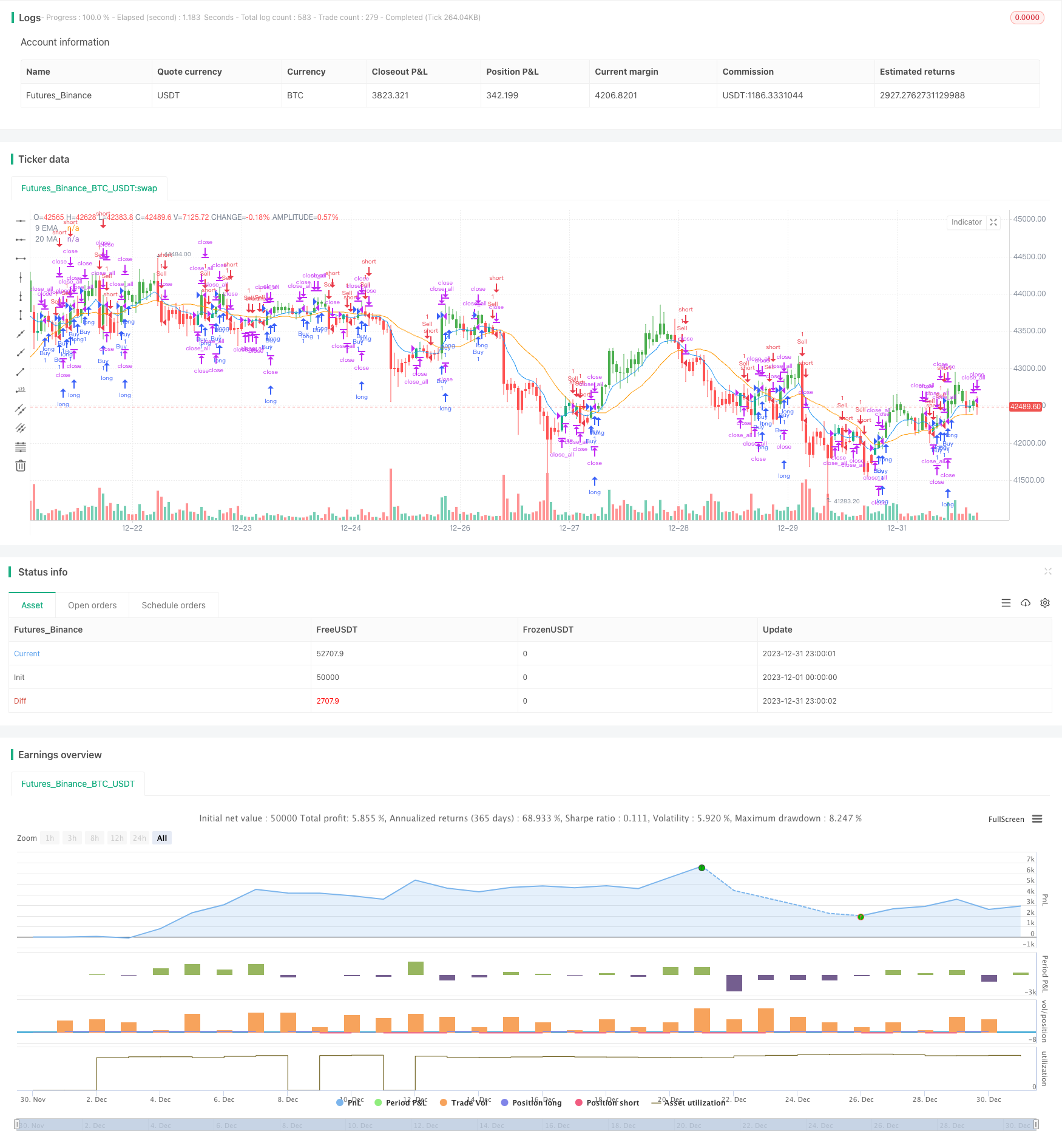
概述
移动平均线交叉与平仓交易策略是一种基于9日指数移动平均线(EMA)和20日简单移动平均线(MA)的价格运动来进行交易操作的策略。该策略利用EMA和MA的交叉信号来判断趋势方向,以发出买入和卖出信号。一旦价格重新跨过移动平均线,该策略会平仓现有头寸。
策略原理
EMA和MA的计算
- EMA9 计算9日的指数移动平均线。EMA赋予最近期价格更大权重,使其更灵敏地响应新的信息。
- MA20 计算20日的简单移动平均线。MA是过去20日收盘价的平均值。
买入和卖出条件
- 买入条件:当收盘价高于9日EMA和20日MA时成立。该信号被视为多头信号。
- 卖出条件:当收盘价低于9日EMA和20日MA时成立。该信号被视为空头信号。
开仓和平仓
- 当买入条件成立时,执行买入开仓操作。
- 当卖出条件成立时,执行卖出开仓操作。
- 当价格重新跨过9日EMA或20日MA时,不论当前持仓方向,执行平仓操作。
K线配色
- 买入K线标为绿色
- 卖出K线标为红色
- 其他K线默认白色
EMA和MA画图
在图表上绘制9日EMA和20日MA曲线,以便观察价格与移动平均线的相对位置。
策略优势分析
该策略融合了EMA和MA两个广泛使用的技术指标,充分利用了它们平滑价格、判断趋势方向的优点。相比单一使用EMA或MA,该组合能提供更可靠的交易信号。
EMA和MA线的交叉信号简单明了,可以清楚判断市场 Bachelder 的变化,避免错误交易。
策略直接在K线上进行视觉化配色,无需复杂计算即可直观判断当前趋势和信号。
自动执行开仓和平仓操作,严格遵循事先制定的交易规则,有助于风险控制。
风险分析
移动平均线属于趋势跟随指标,在盘整时期会产生大量虚假信号。应避免在震荡趋势中使用该策略。
在价格剧烈波动时,移动平均线可能产生滞后,导致错过最佳入场或出场时机。
EMA和MA的参数设置会对交易结果产生很大影响。应调整参数以适应不同品种和交易周期。
自动交易策略无法像人工交易员般应对各种复杂情况,难以在危急时刻关闭误导头寸。应预先设置止损和止盈。
优化方向
可测试不同长度的EMA和MA参数组合,选择产生信号最优且最大限度减少虚假信号的参数。
可结合波动率指标如ATR来过滤部分高风险信号,以控制潜在亏损。
将策略与其他指标或信号结合使用,如量价指标、布林带,来验证信号的可靠性。
添加止损和止盈逻辑以主动控制头寸风险。止损可基于ATR倍数或价格级别来设定。
总结
移动平均线交叉与平仓交易策略通过EMA和MA的交叉为基础判断市场趋势方向,以发出交易信号。该策略简单实用,容易实现自动化交易。但如其他技术指标策略一样,其 parameter 设置和市场情况对结果影响很大,在实战中需要不断调整优化以适应市场变化。
/*backtest
start: 2023-12-01 00:00:00
end: 2023-12-31 23:59:59
period: 1h
basePeriod: 15m
exchanges: [{"eid":"Futures_Binance","currency":"BTC_USDT"}]
*/
//@version=4
strategy("EMA and MA Crossover with Close Strategy", shorttitle="EMA_MA_Close", overlay=true)
// Define the length of the Exponential Moving Average and Moving Average
lengthEMA = 9
lengthMA = 20
// Calculate the 9 EMA and 20 MA
ema9 = ema(close, lengthEMA)
ma20 = sma(close, lengthMA)
// Define the buy and sell conditions
buyCondition = close > ema9 and close > ma20
sellCondition = close < ema9 and close < ma20
// Define the close position condition
closeCondition = crossover(close, ema9) or crossover(close, ma20)
// Execute buy or sell orders
if (buyCondition)
strategy.entry("Buy", strategy.long)
else if (sellCondition)
strategy.entry("Sell", strategy.short)
// Close any position if the close condition is met
if (closeCondition)
strategy.close_all()
// Coloring the candles based on conditions
barcolor(buyCondition ? color.green : na)
barcolor(sellCondition ? color.red : na)
// Plotting the EMA and MA for reference
plot(ema9, color=color.blue, title="9 EMA")
plot(ma20, color=color.orange, title="20 MA")